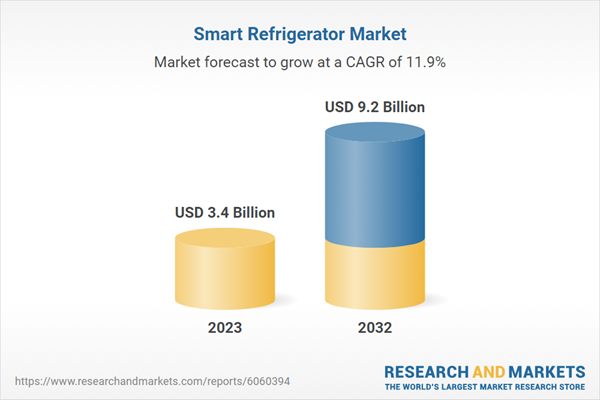The Smart Refrigerator Market was valued at USD 3.4 billion in 2023, and is projected to reach USD 9.2 billion by 2032, rising at a CAGR of 11.9%. Rapid advancements in technology and shifting consumer preferences toward convenience, energy efficiency, and smart home integration are driving this expansion. Smart refrigerators, equipped with IoT-enabled features such as remote monitoring, inventory tracking, and energy management, are gaining popularity among tech-savvy and eco-conscious consumers. These appliances offer enhanced user experiences while aligning with modern home automation trends. The increasing adoption of AI and IoT across smart home devices is expected to accelerate market growth, making smart refrigerators an essential component of connected living. Growing competition among manufacturers is also pushing continuous innovation, further expanding the market’s potential user base. The demand for energy-efficient and time-saving kitchen solutions is prompting consumers to invest in smart refrigeration, reinforcing its rising prominence in the global market.
Freestanding smart refrigerators dominated the industry in 2023, surpassing USD 2.9 billion in revenue and expected to reach USD 7.6 billion by 2032. Their widespread adoption is attributed to versatility in design, ease of installation, and the availability of various sizes and styles to accommodate different consumer needs. These models incorporate touchscreen controls, AI-powered management, and energy-saving functions that appeal to modern households. Their adaptability in placement also makes them a preferred choice over built-in units, adding to their popularity among consumers seeking flexible and advanced refrigeration solutions.
By capacity, the market is segmented into small (10-19 cubic feet), medium (20-29 cubic feet), and large (30+ cubic feet) categories. Medium-sized smart refrigerators generated USD 1.5 billion in 2023 and are forecasted to reach USD 4.2 billion by 2032. These units strike an ideal balance between space and functionality, making them the go-to option for average-sized households. They integrate cutting-edge smart features while remaining energy-efficient and cost-effective. Their versatility in accommodating different storage needs appeals to a wide consumer base looking for reliable and innovative refrigeration solutions.
North America led the smart refrigerator market, generating USD 1.1 billion in 2023, with projections to reach USD 3 billion by 2032. The region’s strong inclination toward smart home technology, high disposable income, and well-developed infrastructure contribute to this dominance. Consumers in North America are willing to invest in premium home automation products that enhance convenience and energy efficiency. Ongoing innovations by key industry players are further fueling the market’s expansion, ensuring continuous advancements in smart refrigeration technology.
This product will be delivered within 2-4 business days.
Freestanding smart refrigerators dominated the industry in 2023, surpassing USD 2.9 billion in revenue and expected to reach USD 7.6 billion by 2032. Their widespread adoption is attributed to versatility in design, ease of installation, and the availability of various sizes and styles to accommodate different consumer needs. These models incorporate touchscreen controls, AI-powered management, and energy-saving functions that appeal to modern households. Their adaptability in placement also makes them a preferred choice over built-in units, adding to their popularity among consumers seeking flexible and advanced refrigeration solutions.
By capacity, the market is segmented into small (10-19 cubic feet), medium (20-29 cubic feet), and large (30+ cubic feet) categories. Medium-sized smart refrigerators generated USD 1.5 billion in 2023 and are forecasted to reach USD 4.2 billion by 2032. These units strike an ideal balance between space and functionality, making them the go-to option for average-sized households. They integrate cutting-edge smart features while remaining energy-efficient and cost-effective. Their versatility in accommodating different storage needs appeals to a wide consumer base looking for reliable and innovative refrigeration solutions.
North America led the smart refrigerator market, generating USD 1.1 billion in 2023, with projections to reach USD 3 billion by 2032. The region’s strong inclination toward smart home technology, high disposable income, and well-developed infrastructure contribute to this dominance. Consumers in North America are willing to invest in premium home automation products that enhance convenience and energy efficiency. Ongoing innovations by key industry players are further fueling the market’s expansion, ensuring continuous advancements in smart refrigeration technology.
Comprehensive Market Analysis and Forecast
- Industry trends, key growth drivers, challenges, future opportunities, and regulatory landscape
- Competitive landscape with Porter’s Five Forces and PESTEL analysis
- Market size, segmentation, and regional forecasts
- In-depth company profiles, business strategies, financial insights, and SWOT analysis
This product will be delivered within 2-4 business days.
Table of Contents
Chapter 1 Methodology & Scope
Chapter 2 Executive Summary
Chapter 3 Industry Insights
Chapter 4 Competitive Landscape, 2023
Chapter 5 Market Estimates & Forecast, by Product, 2021-2032, (USD Billion) (Thousand Units)
Chapter 6 Market Estimates & Forecast, by Type, 2021-2032, (USD Billion) (Thousand Units)
Chapter 7 Market Estimates & Forecast, by Capacity, 2021-2032, (USD Billion) (Thousand Units)
Chapter 8 Market Estimates & Forecast, by Price, 2021-2032, (USD Billion) (Thousand Units)
Chapter 9 Market Estimates & Forecast, by End Use, 2021-2032, (USD Billion) (Thousand Units)
Chapter 10 Market Estimates & Forecast, by Distribution Channel, 2021-2032, (USD Billion) (Thousand Units)
Chapter 11 Market Estimates & Forecast, by Region, 2021-2032, (USD Billion) (Thousand Units)
Chapter 12 Company Profiles (Business Overview, Financial Data, Product Landscape, Strategic Outlook, SWOT Analysis)
Companies Mentioned
The companies featured in this Smart Refrigerator market report include:- Beko
- Bosch Home Appliances
- Electrolux AB
- Fisher & Paykel Appliances Holdings
- GE Appliances
- Haier Smart Home
- Hisense Group
- LG Electronics
- Miele & Cie.
- Panasonic Corporation
- Samsung Electronics
- Sharp Corporation
- Siemens Home Appliances
- Sony Corporation
- Whirlpool Corporation
Table Information
| Report Attribute | Details |
|---|---|
| No. of Pages | 210 |
| Published | February 2025 |
| Forecast Period | 2023 - 2032 |
| Estimated Market Value ( USD | $ 3.4 Billion |
| Forecasted Market Value ( USD | $ 9.2 Billion |
| Compound Annual Growth Rate | 11.9% |
| Regions Covered | Global |
| No. of Companies Mentioned | 16 |









